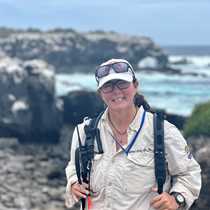Today we spent a full day on the second largest island of the archipelago, Santa Cruz. We had a great introduction to the natural history and conservation of the Giant tortoises of the Galapagos by visiting the headquarters of the National Park and the Darwin Center and exploring their migratory route in the highlands. It was impactful to see them in their natural environment.
We also had the opportunity to visit the town and farms to learn about the human history of the islands.







